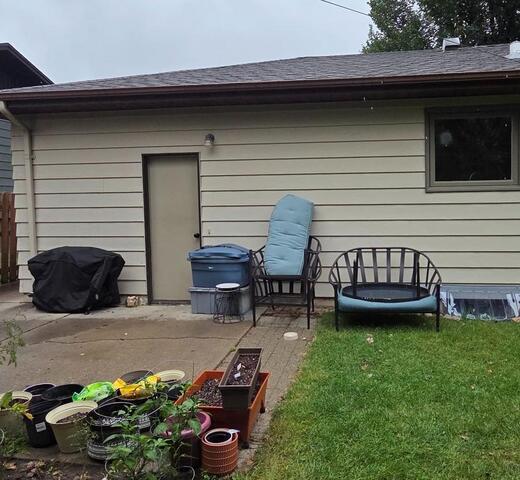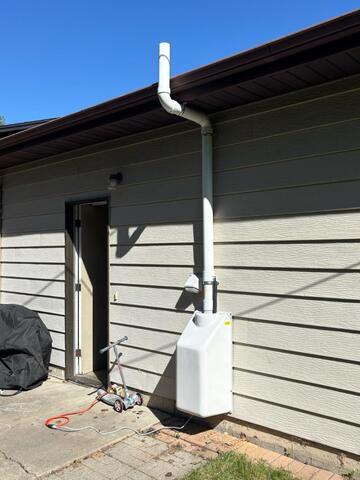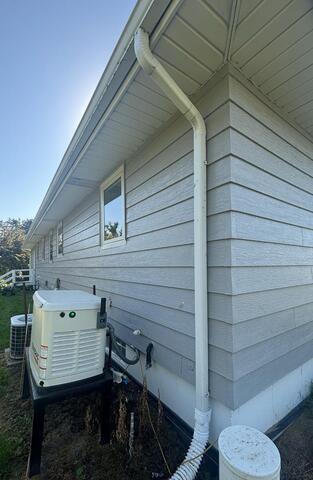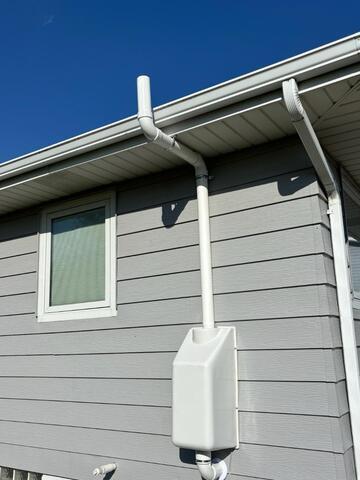Proudly servicing Minnesota, North Dakota, Western Wisconsin, and Northeast Iowa - including Rochester, La Crosse, Minneapolis, Mankato, Fargo, and Mason City
Radon Gas Mitigation Before & After Photos
Click on a photo to enlarge.
Radon Mitigation System Secured in Bismarck, ND
A homeowner in Bismarck, ND, recently read an article discussing the dangers of radon. Worried that this would affect their home, the homeowner knew they needed to look into "radon testing Bismarck, ND". One of the first companies to grab their attention was us, American Waterworks, so the homeowner decided to sign up for their FREE estimate. Once the estimate was set, the homeowner prepared for the arrival of our Design Specialist, Derek. A few days later, Derek traveled to the home to begin the inspection and test. While waiting for the test to complete, Derek began looking for the best place to install the system. Once the test was completed, it confirmed the levels were dangerously high. To prevent these levels from rising, Derek recommended installing a Radon Mitigation System on the outside of the home. Knowing this was the best plan of action, the homeowner agreed and worked with Derek to find the best installation date. When the installation date arrived, our Radon Sales + Service Technician, Jackson, traveled to the home to begin the installation. Jackson promptly arrived at the home and began by installing the Radon Mitigation System on the south side of the home. Once the Radon Mitigation System was secured, Jackson cleaned up his materials and left the home. The homeowner was given peace of mind knowing their home was safe from radon.
High Radon Levels Resolved in Adrian, ND
A homeowner in Adrain, ND, was watching their local news when their attention was caught by a segment discussing the dangers and importance of testing your radon levels. Worried their home could be at risk, the homeowner began looking into radon testing and mitigation near Adrain, ND. One of the first companies to catch their eye was us, American Waterworks, so the homeowner decided to sign up for their FREE estimate. Once the estimate was set, the homeowner awaited the arrival of our Radon Sales & Service Technician, Jackson. Once he arrived, Jackson introduced himself to the homeowner and they performed one of the radon tests. Radon is an invisible, odorless, and tasteless gas that can lead to lung cancer and other health complications. Once the test was complete, Jackson discovered that the levels were significantly high and a radon mitigation system needed to be installed. Jackson shared his findings with the homeowner and recommended installing a radon mitigation system in the home. Wanting to lower their levels, the homeowner decided to go ahead with the proposal. After Jackson received the stamp of approval, he sent the proposal to our office to have it approved. Once the project was approved, Jackson was able to travel back to the home and install the Radon Mitigation System. Jackson successfully installed the Radon Mitigation System outside the home, so he cleaned up his materials and left the home. The homeowner was relieved to know their home was no longer at risk. American Waterworks is happy to remove radon from its customer's homes.
Jamestown, ND, Radon Risk Eliminated
A homeowner in Jamestown, ND, had concerns regarding the radon levels in their home. Knowing they could not repair the space themselves, the homeowner began looking into radon testing near Jamestown, ND. After comparing several companies, the homeowner decided to work with us, American Waterworks. The homeowner saw our Radon Mitigation System and knew we were the best company for the job. Since they were already on our website, the homeowner decided to sign up for their FREE estimate. After the estimate was set, we sent one of our Design Specialists to the home to set the radon test. The Design Specialist set up the test and began looking for places to install the Radon Mitigation System. Once the test was completed, it showed that the home's levels were alarmingly high. The Design Specialist recommended installing the Radon Mitigation System along the north wall. The homeowner agreed with the Design Specialists' recommendations, and the plans were sent to our Logistics team to build and schedule the project. As soon as our Logistics team ironed out the details, we sent Jackson to install the Radon Mitigation System. Jackson promptly arrived at the home and installed the system along the wall. After Jackson completed the installation, he cleaned up his materials and left the home. The homeowner was delighted with Jackson's excellent work. American Waterwork is happy to eliminate radon risks in their customers' homes.
Radon Reduction System Secured in Jamestown, ND
A homeowner in Jamestown, ND, recently watched a television special discussing the dangers of radon. Concerned about the levels in their home, the homeowner knew they needed an expert to provide them with a solution. One of the first companies to grab their attention was us, American Waterworks, so the homeowner decided to sign up for their FREE estimate. Once the estimate was set, the homeowner prepared for the arrival of our Radon Sales + Service Technician, Jackson. A few days later, Jackson traveled to the home to begin the inspection and test. While the test completed, Jackson began looking for the best place to install the system. Once the test was completed, it showed that the levels were alarmingly high. To stop the levels from rising, Jackson recommended installing a Radon Mitigation System on the outside of the home. Knowing this was the best plan of action, the homeowner agreed and worked with Derek to find the best installation date. When the installation date arrived, our Radon Sales + Service Technician, Jackson, traveled to the home to begin the installation. Jackson promptly arrived at the home and began by installing the Radon Mitigation System on the side of the home. Once the Radon Mitigation System was secured, Jackson cleaned up his materials and left the home. The homeowner was relieved to know the radon was properly mitigated.
Radon Gas Mitigated from Adrian, MN, Home
A homeowner from Adrian, MN, was at his local home improvement store one day when he noticed an at-home radon gas testing kit. He didn't know much about the dangers of radon gas but knew that if levels in his home were high, he might need to take action. After conducting a test himself, he was floored when the results came back at 23 pCi/L. Panicked, he decided to find Minnesota radon specialists who could help. After finding our website, he was impressed with our radon mitigation pictures from other projects in his area and decided to sign up for his FREE estimate.
Several weeks later, our Design Specialist, Tony B, was headed out to the home. When Tony arrived, he got right to work inspecting the home. When he finished, he met with the homeowner. He first commended him for calling in an expert, as radon gas is odorless, colorless, and tasteless, making it impossible to detect without proper testing. He went on to say that, the Environmental Protection Agency recommends taking action for any levels higher than 4 pCi/L, and that because of the elevated levels in the home, he was recommending a radon mitigation system be installed. Tony explained that a typical radon mitigation system consists of a large-diameter plastic pipe that connects the air beneath your foundation to the outdoors. An in-line fan sucks radon-rich air from beneath your foundation and expels this hazardous air to the exterior. Instead of entering your basement or other living space area through numerous gaps and cracks in the foundation, radon gas is extracted from beneath your foundation before it can permeate into interior space. He finished by saying that, when installed by a licensed professional, a radon mitigation system will lower the concentration of radon gas in the interior air to minimal levels recommended by the EPA and other health agencies. The homeowner liked Tony's plan and scheduled the work for several weeks later.
On the day of the installation, our Foreman, Dakota, and his team were able to seamlessly place the system within the home, successfully restoring the homeowner's faith in the air circulating his home!
Do you know about radon gas and the dangers it poses to a household? Click HERE for your FREE estimate!
our service area
We serve the following areas
- Alexander
- Almont
- Amidon
- Arnegard
- Beach
- Belfield
- Beulah
- Bowman
- Carson
- Cartwright
- Dickinson
- Dodge
- Dunn Center
- Epping
- Fairfield
- Flasher
- Fort Yates
- Gladstone
- Glen Ullin
- Golden Valley
- Golva
- Grassy Butte
- Halliday
- Hebron
- Hettinger
- Keene
- Killdeer
- Lefor
- Manning
- Marmarth
- Medora
- Mott
- New England
- New Leipzig
- Raleigh
- Reeder
- Regent
- Rhame
- Richardton
- Scranton
- Selfridge
- Sentinel Butte
- Shields
- Solen
- South Heart
- Taylor
- Trenton
- Watford City
- Williston











